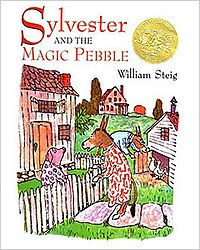
Steig, W. (1969).
Sylvester and the magic pebble. New York: Windmill Books.
Sylvester and the Magic Pebble by William Steig won the Caldecott Medal in 1970. It was one of my favorite books as a child. I love sharing it with my middle school students, because it can be a vital resource for teaching the elements of fiction. It is also such an interesting story; it keeps readers on the edge of their seats.
This book is appropriate for children in kindergarten through high school. There are so many ways to tie this book in with the elements of fiction. For example, students could simply study the plot and character or even analyze how the character changed.
The book centers around the
main character, Sylvester. He is a pebble collector, and is specifically interested in pebbles with unusual shapes and colors. He finds a very special pebble that can make wishes, but before he can use the magic to do good, he accidentally changes himself into a rock to escape a lion. The book goes on to follow Sylvester's depressive state due to being separated from his parents and coming to terms with living out his life as a rock.
This is a great story that follows a
chronological plot. There are two main types of conflict in the story, which are
person versus self and
person versus nature. The person versus self conflict is evident in Sylvester's depressive state where he blames himself for being a rock, his family missing him, and his struggle with being separated from his family. This would be an excellent example for middle and high school students to look at when studying how characters struggle in with internal conflicts and change as a result of them. The person versus nature conflict occurs between Sylvester and the lion, which would be an excellent example for elementary students to look at. The conflict between Sylvester and the lion is external, so it is fairly easier for readers to identify it and explain how it changed Sylvester's life.
Unlike most children's book, this book truly lets you understand the characters feelings. The author does this through a strong use of
characterization. The author fully describes Sylvester's inner thoughts during his struggle of being a rock and actually hearing his family around him. There are also descriptions of Sylvester by his parents, descriptions of his senseless actions with magic, dialogue from him explaining his feelings, and his physical appearance is shown through the illustrations.
This book is also useful for teaching
theme. I used it last year with my sixth graders when we were learning about theme and they really enjoyed it. It was amazing all of the themes they came up with and evidence to back it up. One of the most popular themes across all of the classes was "sometimes people have all that they need, a family that loves them." They felt that they could really relate to this, because like most kids today they always want more. This story is overall a great example of the importance of family.
The story is also an easy read with straightforward language that explains each event; furthermore, the
sentences and
organization flow easily, which makes it appropriate for all ages. The
illustrations in the book are also realistic with a twist. Everything except the animals in clothing is a replica of a real town. For example, the houses, the clothing, the police, and natural elements are represented in a realistic form.

This story has so many details in this story that can be analyzed by students. Some big questions that students can focus on are:
1. How does Sylvester change throughout the story? Give evidence from the text to support your answer.
2. The author uses pigs to represent the police. How does our society use pigs to symbolize the police? (This is a controversial question that is most appropriate for older students. It also relates to how the police in the story react to Sylvester's disappearance.)
3. How does the author show how dangerous power can be in the wrong hands? Give evidence from the text to support your answer.
4. How does the topic of family develop throughout the text?
Common Core Standards that this story connects to are:
CCSS.ELA-Literacy.RL.7.1 Cite several pieces of textual evidence to support analysis of what the text says explicitly as well as inferences drawn from the text.
CCSS.ELA-Literacy.RL.7.2 Determine a theme or central idea of a text and analyze its development over the course of the text; provide an objective summary of the text.
CCSS.ELA-Literacy.RL.7.3 Analyze how particular elements of a story or drama interact (e.g., how setting shapes the characters or plot).



 Myers, W. D. (1999). Monster. New York, NY: Harper Collins.
Myers, W. D. (1999). Monster. New York, NY: Harper Collins. 

 Steig, W. (1969). Sylvester and the magic pebble. New York: Windmill Books.
Steig, W. (1969). Sylvester and the magic pebble. New York: Windmill Books. 